Cauliflower mushroom (Sparassis crispa), also known as the "sparassis" or "wood cauliflower," is a unique and distinctive saprobic wild mushroom that is highly regarded by foragers and mushroom enthusiasts.
The cauliflower fungus is highly sought after for its culinary appeal and unique appearance. However, due to their somewhat limited distribution and seasonal availability, they are considered a special wild food find among mushroom foragers and chefs.
Cauliflower mushroom Identification
Physical Characteristics:
- Shape: Cauliflower mushrooms have a striking appearance that resembles a head of cauliflower. They consist of multiple folded, frilly, and irregularly shaped clusters of pale to creamy-white branches.
- Size: These mushrooms can range in size from small, cauliflower-sized specimens to larger ones measuring up to a foot or more in diameter.
- Cap Color: The upper surface of the cauliflower mushroom’s cap is typically creamy white to pale yellow or light beige when it’s young. As it matures, it may develop a more pronounced yellow or brownish tint.
- Texture: The mushroom’s texture is often described as somewhat crisp, resembling cooked cauliflower when prepared.
- Spore print: Typically, the spore print of this mushroom is creamy white to pale yellow or light yellow.
As with all edible mushrooms, caution should be exercised when foraging for cauliflower mushrooms. Be sure you can accurately identify them, as they have toxic lookalikes.
What Are You Foraging For Right Now?
We're thrilled to hear your ideas. What would you like to submit today? Feel free to share your thoughts and experiences with us.
Always consult field guides, experts, or local mycological societies for proper identification and safe foraging practices.
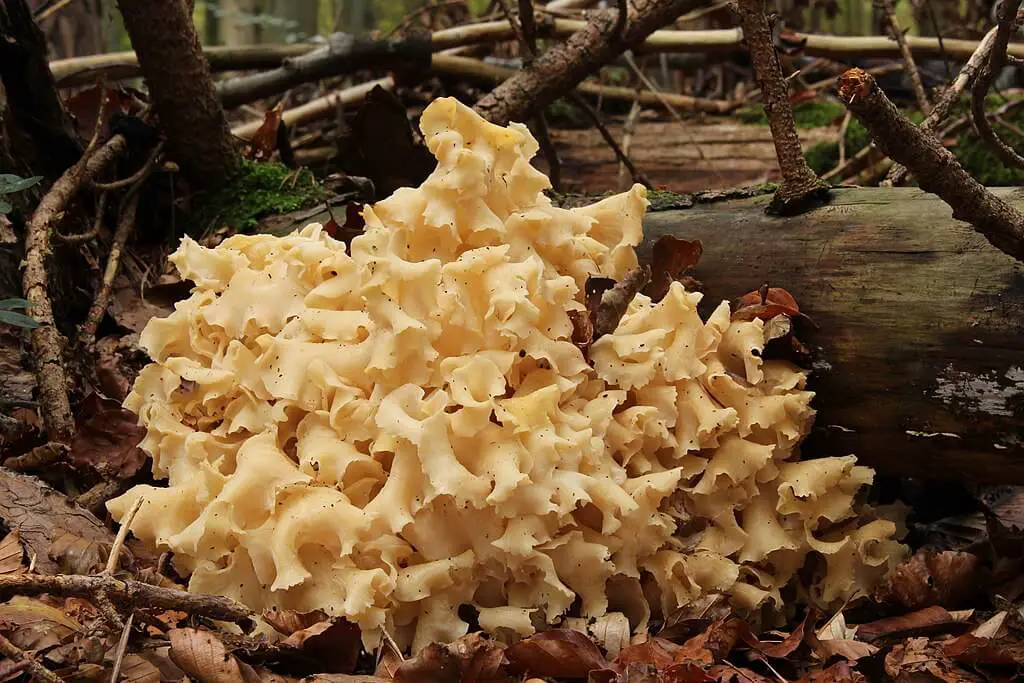
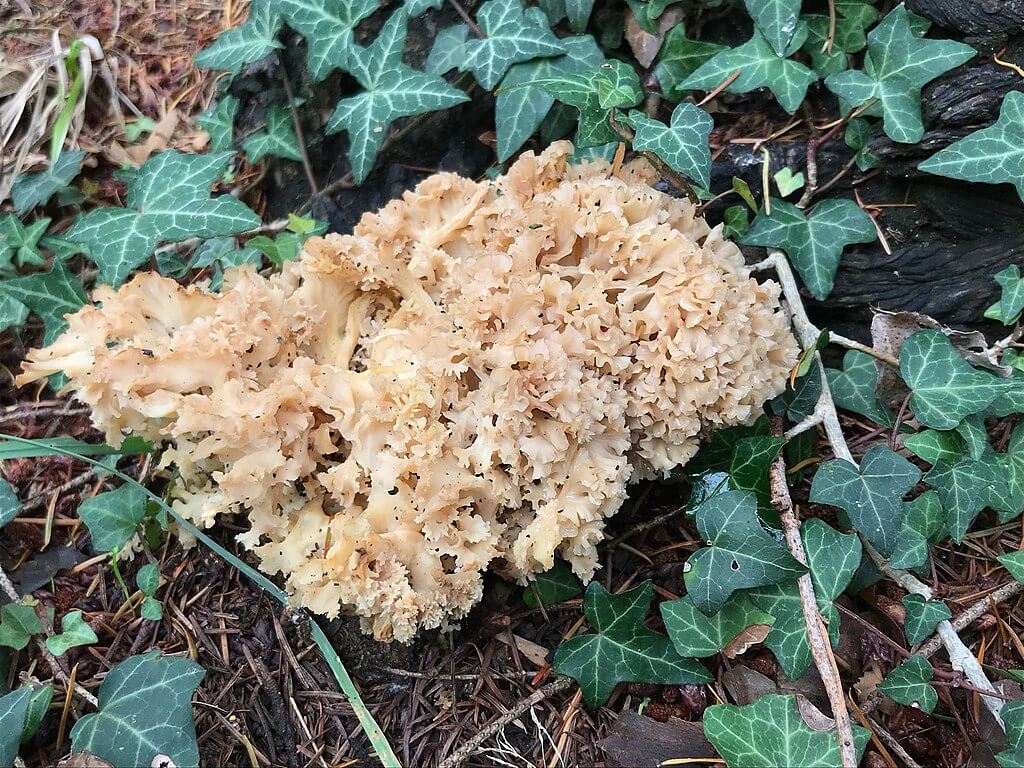
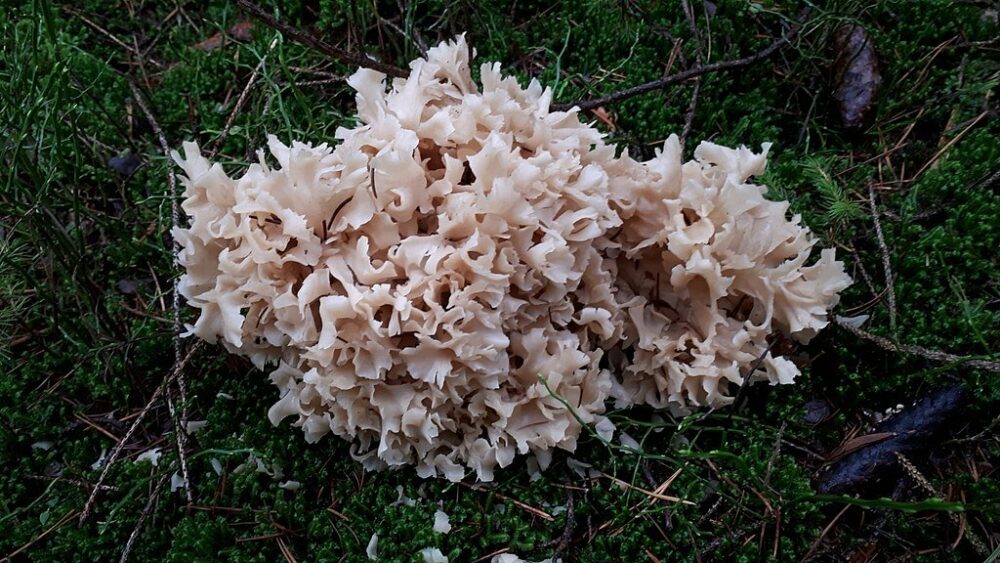
Where can you find cauliflower mushrooms?
They are most commonly associated with hardwood trees, especially oaks, but they can also be found near other hardwoods like beech, hickory, and maple. For more information of where this mushroom grown in the U.S., check below under ‘foraging for cauliflower mushrooms.
Cauliflower mushrooms are typically found in the late summer through the fall, with their appearance often linked to the rainy or damp conditions of late summer and early autumn.
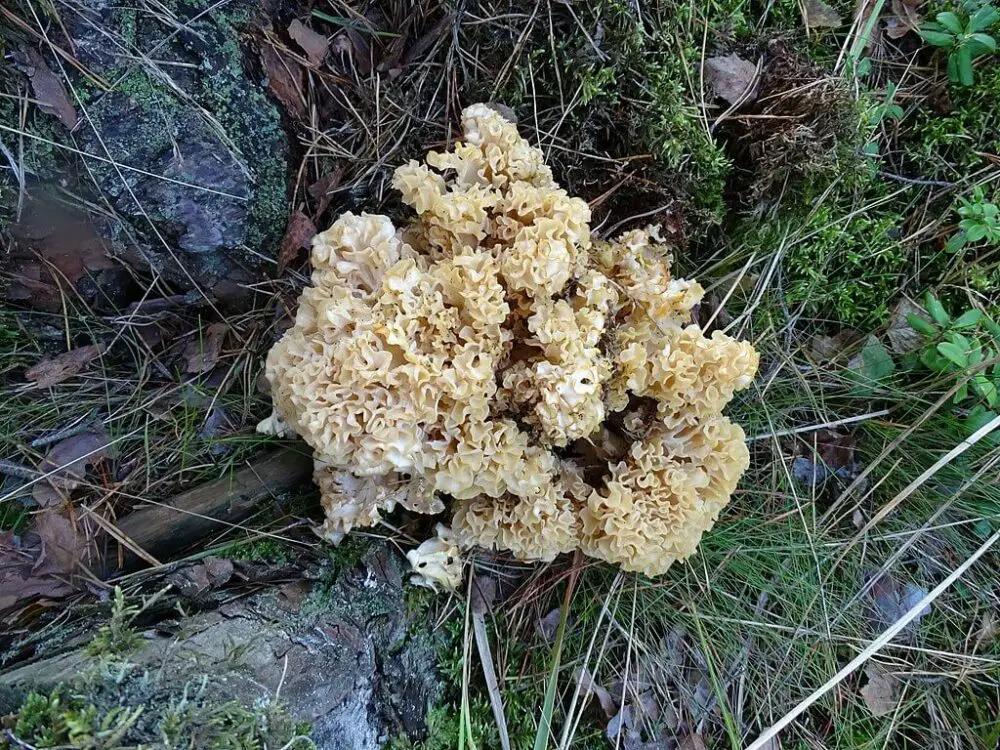
Is a cauliflower mushroom edible?
Yes, cauliflower mushrooms are edible, and they are considered a culinary delicacy by many foragers and chefs. They are prized for their unique appearance, flavor, and versatility in various dishes.
Make sure to cook them thoroughly to ensure they are safe to eat, as consuming them raw or undercooked can cause mild gastrointestinal distress in some individuals.
What does the cauliflower mushroom taste like?
When properly prepared, cauliflower mushrooms have a mild, nutty, and somewhat sweet flavor.
The texture of cauliflower mushrooms, when cooked, can be crisp, resembling cooked cauliflower, but with a distinct mushroom taste.
The mildness of their flavor makes them a popular choice for incorporating into various recipes, from stir-fries and pasta dishes to soups and sautés.
What can cauliflower mushrooms be used for?
Here are some cauliflower mushroom recipes:
Sautéed or Stir-Fried: Sauté or stir-fry cauliflower mushrooms with garlic, butter, or olive oil, and your choice of vegetables. They absorb flavors well and add a delightful texture to the dish.
Roasted: Toss cauliflower mushrooms with olive oil, herbs, and seasonings, then roast them in the oven until they become crispy and caramelized. Roasted cauliflower mushrooms can be served as a side dish or a topping for salads and pasta.
In Soups and Stews: Add sliced or chopped cauliflower mushrooms to soups, stews, and broths. They can impart their flavor and absorb the flavors of the broth, enhancing the overall taste of the dish.
Pasta Dishes: Use cauliflower mushrooms as a flavorful addition to pasta dishes. They pair well with pasta, cream-based sauces, and a variety of other ingredients like cheese and fresh herbs.
Egg noodles: This dish offers a gluten-free, low-carb alternative to traditional egg noodles and can be a tasty addition to various recipes. Trim the cauliflower mushroom into thin, noodle-like strips. Sauté the noodles, stirring occasionally, for about 5-7 minutes or until they become tender and take on a slightly light brown color.
As a Meat Substitute: Due to their meaty texture and umami flavor, cauliflower mushrooms can serve as a meat substitute in vegetarian or vegan dishes. They work well in recipes like vegetarian stir-fries or pasta dishes.
Pickled: Pickling cauliflower mushrooms is another way to preserve and enjoy their unique flavor. They can be used as a tangy and flavorful addition to sandwiches, salads, or charcuterie boards.
Pizza Toppings: Sliced cauliflower mushrooms can be used as a topping for homemade pizzas, adding an earthy and savory element to your pizza creations.
Casseroles: Include cauliflower mushrooms in casseroles and baked dishes for an extra layer of flavor and a unique textural component.
Creamy Dishes: Their mild flavor and ability to absorb creamy sauces make cauliflower mushrooms a great addition to dishes like creamy risottos and Alfredo pasta.
When cooking with cauliflower mushrooms, it’s essential to clean them thoroughly to remove any dirt or debris.

Foraging for cauliflower mushrooms
Where to forage
They are more commonly found in the northeastern and northwestern parts of the country, as well as in the Appalachian region.
Here are some specific areas where you might find cauliflower mushrooms in the United States:
Northeastern United States
States in the Northeast, such as New York, Vermont, New Hampshire, and Maine, have suitable habitats for cauliflower mushrooms. They are often associated with oak and beech trees in this region.
Pacific Northwest
In the Pacific Northwest, including Oregon and Washington, cauliflower mushrooms can be found in coniferous and hardwood forests. They are frequently located near Douglas fir and oak trees.
Appalachian Region
States in the Appalachian Mountains, including parts of West Virginia, Kentucky, Tennessee, and North Carolina, offer potential habitats for cauliflower mushrooms. They can be found near hardwood trees in these areas.
Upper Midwest
Some areas in the upper Midwest, including Wisconsin and Michigan, also have suitable conditions for cauliflower mushrooms, particularly in mixed hardwood and coniferous forests.
Other Regions
While cauliflower mushrooms are more prevalent in the regions mentioned above, they can occasionally be found in other parts of the country where hardwood trees grow.
Check out our guides for the most common, edible mushrooms in:
When to forage
Late Summer to Early Fall
In many parts of North America, including the northeastern and northwestern regions, cauliflower mushrooms tend to appear in late summer, usually starting in August or September. This is when the conditions are often right for their growth.
Moist Conditions
Cauliflower mushrooms are often associated with damp or rainy conditions. A period of rain or consistent moisture followed by warm weather can trigger their growth. In regions with Mediterranean climates, you may find them in the fall and even into the winter months if the weather remains mild and wet.
Temperature Matters
While they are often associated with cooler weather, the specific timing can vary based on temperature and local climate conditions. In some areas, you might find cauliflower mushrooms earlier in the season if the weather cools down sooner.
Tree Associations
Keep in mind that cauliflower mushrooms are mycorrhizal fungi, which means they form symbiotic relationships with tree roots. They are often found near hardwood trees, especially oaks, beech, and other deciduous trees. Understanding the trees in your foraging area can help you pinpoint potential locations.
Harvesting
- Harvest cauliflower mushrooms by cutting or gently pulling them from the base of the tree where they are attached.
- Be sure to leave a portion of the mushroom attached to the tree to allow for future growth and sustainability.
Cauliflower mushroom lookalikes
Cauliflower mushrooms have a unique appearance that makes them relatively easy to identify, especially when you’re familiar with their characteristics.
However, like all wild mushrooms, they do have some potential lookalikes that can lead to confusion.
Hen of the Woods (Grifola frondosa) – edible
Hen of the woods, also known as maitake, is a close lookalike. It has a similar growth pattern, forming large clusters of overlapping, fan-shaped caps.
However, maitake lacks the distinct “cauliflower” appearance and has a different texture.
Lion’s Mane Mushroom (Hericium erinaceus) – edible
Lion’s mane is another mushroom that grows in a similar way to cauliflower mushrooms, with a cascading, creamy-white appearance.
However, lion’s mane has long, spiky spines rather than the finely divided branches of cauliflower mushrooms.
Coral Mushrooms (Ramaria spp.) – many species edible
Some species of coral mushrooms, particularly those with white or creamy-colored branches, can resemble cauliflower mushrooms at a glance.
However, coral mushrooms usually have a more intricate branching pattern.
Sparassis radicata (Rooting Cauliflower Mushroom) – edible
This species is a close relative of Sparassis crispa and can appear similar. However, it tends to grow at the base of hardwood trees and lacks the well-defined, above-ground, cauliflower-like appearance.
Sparassis spatulata (Spatula-Shaped Cauliflower Mushroom) – edible
Sparassis spathulata has a fan-shaped or spatula-shaped fruiting body that resembles a cauliflower mushroom to some extent. Its lobes or segments are often more flattened and elongated compared to Sparassis crispa.
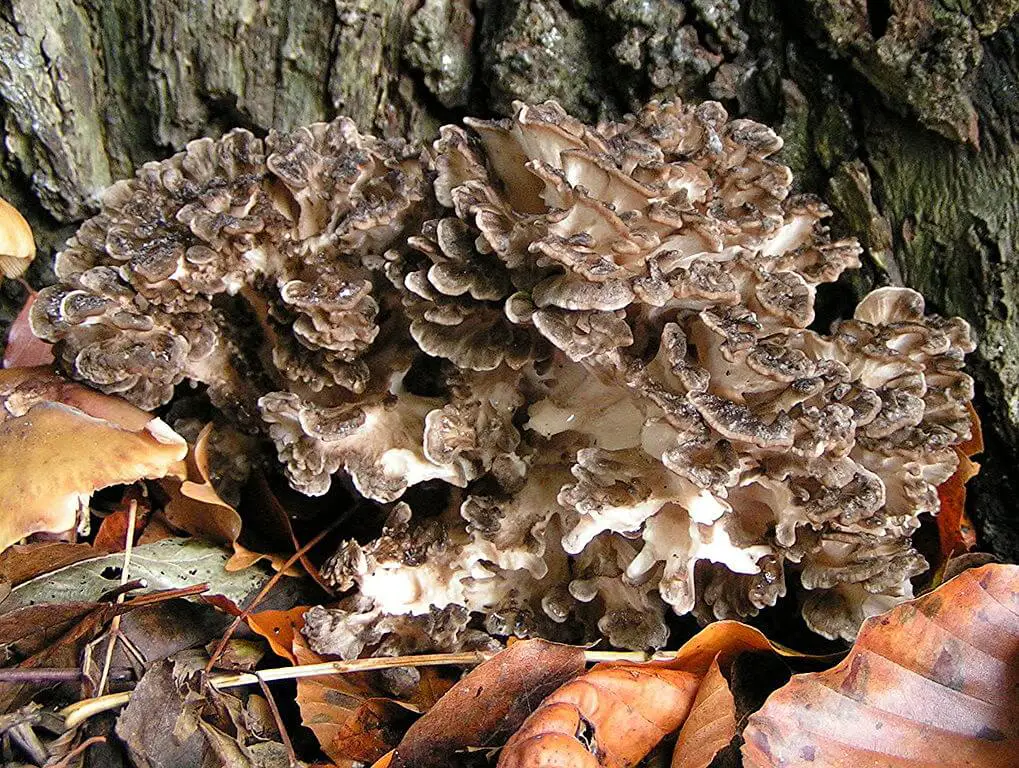

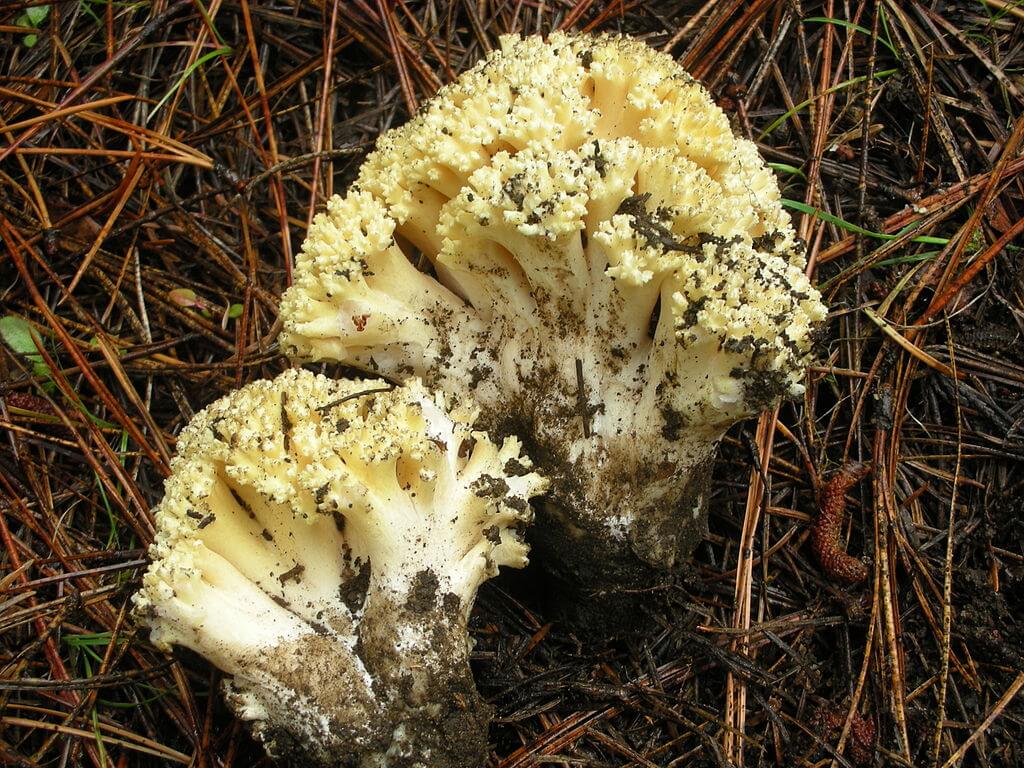
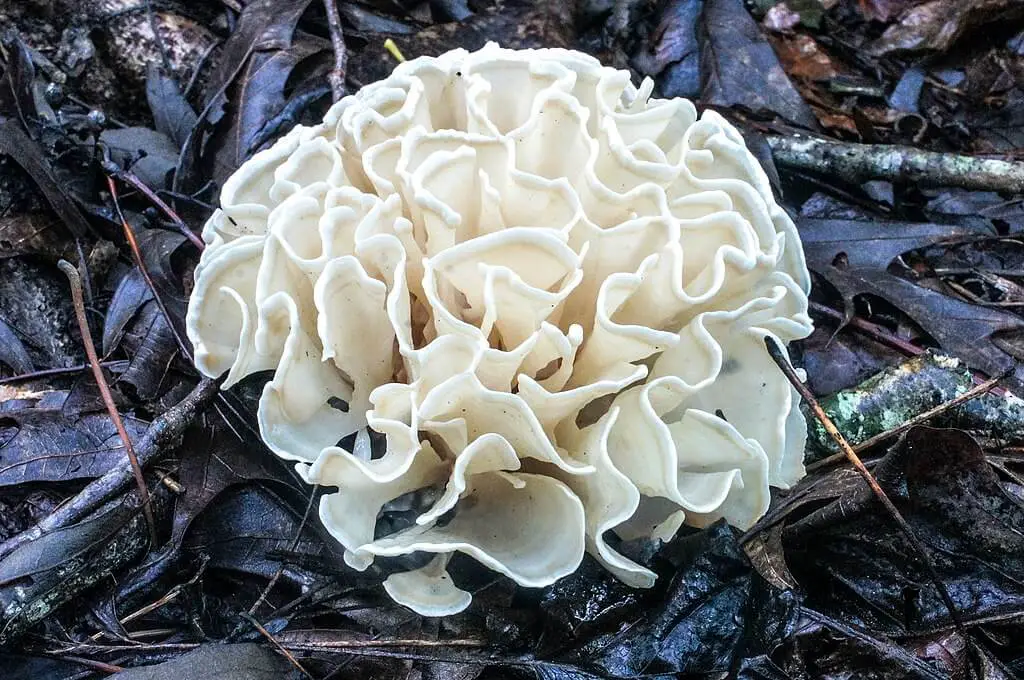
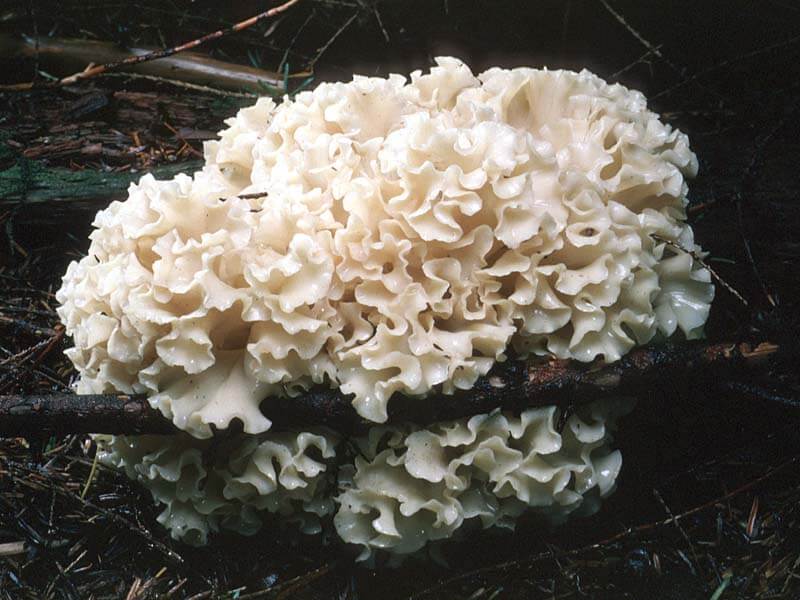
Ana has always been interested in all things nature and flora. With her expertise in home gardening and interest in foraging, she has been spending her weekends and free time looking for edible native plants, flowers, and fungi. One of her many hobbies includes testing new savory and sweet recipes, juices or teas made from freshly picked plants, wild fruits, or mushrooms.

